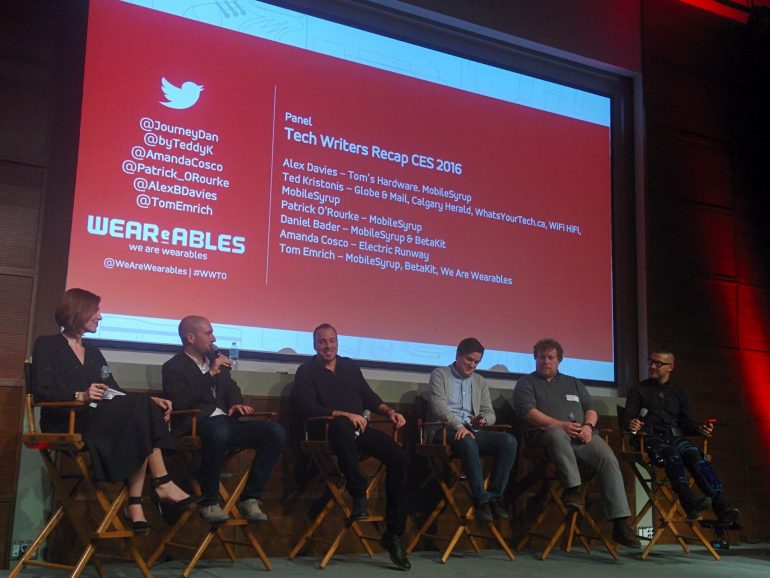Not many people can say they’ve celebrated their birthday with hundreds of people while decked out in a bionic exoskeleton that helps people restore walking ability. But We Are Wearables founder and BetaKit senior editor Tom Emrich can. He kicked off the year’s first We Are Wearables — which focused on some major wearable trends coming out of CES, and included a teleconferenced interview with 3Glasses VR vice president Philip Wong from China — on his birthday, wearing a Keeogo exoskeleton, and talked about some major 2015 milestones and changes to We Are Wearables itself.
“We want wearables to look like the clothing that we’re used to rather than looking like technology.”
After a town hall with the WWTO community back in December, Emrich announced that the large We Are Wearables events that everyone has grown used to will happen every quarter rather than every month; instead, more intimate events like workshops and speed networking with the community will take its place. All events will be free so that WWTO can remain accessible. “The community wants to see more ‘value and action’ and the opportunity to speak with thought leaders,” Emrich said of the decision. “They want to walk away with actual skills in wearables.”
The panel discussion featured journalists that covered CES, a global consumer electronics trade show, both in-person and remotely. They were which included Ted Kristonis, a tech journalist with bylines in MobileSyrup and the Globe and Mail; Patrick O’Rourke, senior editor at MobileSyrup; Alex Davies with Tom’s Hardware; Amanda Cosco, founder of Electric Runway; and Daniel Bader, editor-in-chief of MobileSyrup. Many of the panelists agreed that wearables seemed to be past the ‘prototyping’ phase and companies were ready to get serious about widespread consumer adoption.
Tom Emrich wearing @ablebionics exoskeleton during the first #WWTO #2016 at @marsdd #MarsD… https://t.co/IABktEhqjB pic.twitter.com/QKB5KPcnoG
— Brian deRivera Simon (@Tarsipix) January 26, 2016
“A lot of the products that we’d seen in 2014 and 2015 were shipping products in 2016,” said Bader. He gave the example of the HTC Vive, which he recalled as a rough protoype during its premiere in March 2015. At the recent CES, the Vive was shown off as an almost completely-finished, sleek product. “We’ve reached a point where the internal hardware has reached a price-to-performance ratio where you can get products down to a meaningful price point. They’re not being shown off at $10,000 or $30,000 price points anymore.”
This maturation is also leading companies to take the convergence of fashion and tech more seriously, Cosco pointed out.
“We want wearables to look like the clothing that we’re used to rather than looking like technology. A big example of this was the Samsung smart belt which looked like a normal belt but had sensors embedded. Fashion and wearables will have to play nice,” Cosco said. “The second thing is that we’re not going to have the ‘iPhone wearable technology’. I think everyone is waiting for that one product, but I don’t think we’ll see that.”
As wearables move beyond our immediate space, Emrich noted that wearable companies in the VR spaces are trying to find ways to integrate more of the physical world. “People know that you can put your eyes in the physical world but we’re more than just eyes.”
The night ended off with a presentation Toronto-based Sonic Wear, which is developing the motion-tracking SoMo wearable that turns movement into music.
.@somobysonicwear street dance. Making music with movement #wwto #wearabletech pic.twitter.com/IHwDwgzYWX
— We Are Wearables (@WeAreWearables) January 26, 2016
After a strong 2015 which saw We Are Wearables extend its online presence to 90,000 people and $750 donated to the Better Day Alliance Foundation, Emrich, ultimately, expressed his hope that WWTO would only grow to be bigger and attract more international names.
“People want big speakers, someone mentioned that they want Tim Cook and Larry Page,” Emrich laughed. But he mentioned that Meta Glasses, which attended a past WWTO event, didn’t even have Toronto on their radar and WWTO got their attention. “You guys are helping to put us on the map for those that are outside of the city. That’s why this is so important.”


